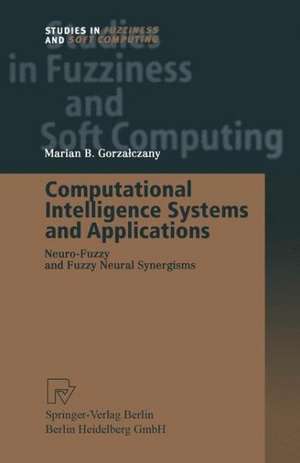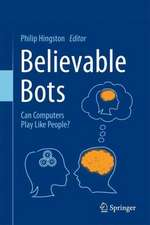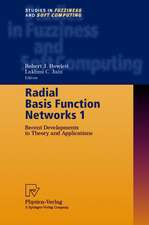Computational Intelligence Systems and Applications: Neuro-Fuzzy and Fuzzy Neural Synergisms: Studies in Fuzziness and Soft Computing, cartea 86
Autor Marian B. Gorzalczanyen Limba Engleză Paperback – 4 aug 2012
| Toate formatele și edițiile | Preț | Express |
|---|---|---|
| Paperback (1) | 974.22 lei 6-8 săpt. | |
| Physica-Verlag HD – 4 aug 2012 | 974.22 lei 6-8 săpt. | |
| Hardback (1) | 980.73 lei 6-8 săpt. | |
| Physica-Verlag HD – 14 dec 2001 | 980.73 lei 6-8 săpt. |
Din seria Studies in Fuzziness and Soft Computing
- 20%
 Preț: 982.99 lei
Preț: 982.99 lei - 20%
 Preț: 642.05 lei
Preț: 642.05 lei - 20%
 Preț: 284.42 lei
Preț: 284.42 lei - 20%
 Preț: 872.96 lei
Preț: 872.96 lei - 20%
 Preț: 914.87 lei
Preț: 914.87 lei - 20%
 Preț: 1033.25 lei
Preț: 1033.25 lei - 20%
 Preț: 975.69 lei
Preț: 975.69 lei - 20%
 Preț: 644.82 lei
Preț: 644.82 lei - 20%
 Preț: 984.96 lei
Preț: 984.96 lei - 18%
 Preț: 938.04 lei
Preț: 938.04 lei - 20%
 Preț: 324.56 lei
Preț: 324.56 lei - 20%
 Preț: 327.45 lei
Preț: 327.45 lei - 20%
 Preț: 980.73 lei
Preț: 980.73 lei -
 Preț: 385.06 lei
Preț: 385.06 lei - 20%
 Preț: 636.88 lei
Preț: 636.88 lei - 20%
 Preț: 969.37 lei
Preț: 969.37 lei - 18%
 Preț: 942.39 lei
Preț: 942.39 lei - 20%
 Preț: 979.59 lei
Preț: 979.59 lei - 20%
 Preț: 982.49 lei
Preț: 982.49 lei - 15%
 Preț: 635.55 lei
Preț: 635.55 lei - 20%
 Preț: 640.59 lei
Preț: 640.59 lei - 20%
 Preț: 981.06 lei
Preț: 981.06 lei - 15%
 Preț: 630.23 lei
Preț: 630.23 lei - 20%
 Preț: 992.70 lei
Preț: 992.70 lei - 20%
 Preț: 975.87 lei
Preț: 975.87 lei -
 Preț: 382.22 lei
Preț: 382.22 lei - 18%
 Preț: 1202.76 lei
Preț: 1202.76 lei - 20%
 Preț: 640.46 lei
Preț: 640.46 lei - 18%
 Preț: 935.55 lei
Preț: 935.55 lei - 18%
 Preț: 932.61 lei
Preț: 932.61 lei
Preț: 974.22 lei
Preț vechi: 1217.78 lei
-20% Nou
Puncte Express: 1461
Preț estimativ în valută:
186.53€ • 194.24$ • 154.76£
186.53€ • 194.24$ • 154.76£
Carte tipărită la comandă
Livrare economică 13-27 februarie
Preluare comenzi: 021 569.72.76
Specificații
ISBN-13: 9783662003343
ISBN-10: 3662003341
Pagini: 376
Ilustrații: X, 364 p.
Dimensiuni: 155 x 235 x 20 mm
Greutate: 0.53 kg
Ediția:Softcover reprint of the original 1st ed. 2002
Editura: Physica-Verlag HD
Colecția Physica
Seria Studies in Fuzziness and Soft Computing
Locul publicării:Heidelberg, Germany
ISBN-10: 3662003341
Pagini: 376
Ilustrații: X, 364 p.
Dimensiuni: 155 x 235 x 20 mm
Greutate: 0.53 kg
Ediția:Softcover reprint of the original 1st ed. 2002
Editura: Physica-Verlag HD
Colecția Physica
Seria Studies in Fuzziness and Soft Computing
Locul publicării:Heidelberg, Germany
Public țintă
ResearchCuprins
1 Introduction.- 1.1 A general concept of computational intelligence.- 1.2 The building blocks of computational intelligence systems.- 1.3 Objectives and scope of this book.- 2 Elements of the theory of fuzzy sets.- 2.1 Basic notions, operations on fuzzy sets, and fuzzy relations.- 2.2 Fuzzy inference systems.- 3 Essentials of artificial neural networks.- 3.1 Processing elements and multilayer perceptrons.- 3.2 Radial basis function networks.- 4 Brief introduction to genetic algorithms.- 4.1 Basic components of genetic algorithms.- 4.2 Theoretical introduction to genetic computing.- 5 Main directions of combining artificial neural networks, fuzzy sets and evolutionary computations in designing computational intelligence systems.- 5.1 Artificial intelligence versus computational intelligence.- 5.2 Designing computational intelligence systems.- 5.3 Selected neuro-fuzzy systems.- 6 Neuro-fuzzy(-genetic) system for synthesizing rule-based knowledge from data.- 6.1 Synthesizing rule-based knowledge from data — statement of the problem.- 6.2 Neuro-fuzzy system in learning mode — problem of knowledge acquisition.- 6.3 Neuro-fuzzy system in inference mode — approximate inference engine.- 6.4 Learning techniques.- 6.5 A numerical example of synthesizing rule-based knowledge from data — modelling the Mackey-Glass chaotic time series.- 6.6 Synthesizing rule-based knowledge from “fish data”.- 7 Rule-based neuro-fuzzy modelling of dynamic systems and designing of controllers.- 7.1 System identification — statement of the problem and its general solution in the framework of neuro-fuzzy methodology.- 7.2 Rule-based neuro-fuzzy modelling of an industrial gas furnace system.- 7.3 Designing the neuro-fuzzy controller for a simulated backing up of a truck.- 8Neuro-fuzzy(-genetic) rule-based classifier designed from data for intelligent decision support.- 8.1 Designing the classifier from data — statement of the problem.- 8.2 Learning mode of neuro-fuzzy classifier.- 8.3 Inference (decision making) mode of neuro-fuzzy classifier.- 8.4 Neuro-fuzzy decision support system for diagnosing breast cancer.- 8.5 Neuro-fuzzy-genetic decision support system for the glass identification problem (forensic science).- 8.6 Neuro-fuzzy-genetic decision support system for determining the age of abalone (marine biology).- 9 Fuzzy neural network for system modelling and control.- 9.1 Learning mode of the network.- 9.2 Inference mode of the network.- 9.3 Fuzzy neural modelling of dynamic systems (an industrial gas furnace system).- 9.4 Fuzzy neural controller.- 10 Fuzzy neural classifier.- 10.1 Learning and inference modes of the classifier.- 10.2 Fuzzy neural classifier for diagnosis of surgical cases in the domain of equine colic.- A Appendices.- A.1.1 Inputs.- A.1.2 Output.- A.2.1 Inputs.- A.2.2 Outputs — set of two class labels.- A.3.1 Inputs.- A.3.2 Outputs — set of two class labels.- A.4.1 Inputs.- A.4.2 Outputs — set of three class labels.- A.5.1 Inputs.- A.5.2 Outputs — three sets of class labels.- References.
Textul de pe ultima copertă
This book presents new concepts and implementations of Computational Intelligence (CI) systems (based on neuro-fuzzy and fuzzy neural synergisms) and a broad comparative analysis with the best-known existing neuro-fuzzy systems as well as with systems representing other knowledge-discovery techniques such as rough sets, decision trees, regression trees, probabilistic rule induction etc. This presentation is preceded by a discussion of the main directions of synthesizing fuzzy sets, artificial neural networks and genetic algorithms in the framework of designing CI systems. In order to keep the book self-contained, introductions to the basic concepts of fuzzy systems, artificial neural networks and genetic algorithms are given. This book is intended for researchers and practitioners in AI/CI fields and for students of computer science or neighbouring areas.
Caracteristici
Self-contained presentation of new concepts and structures of CI systems and their real-life applications Includes supplementary material: sn.pub/extras













